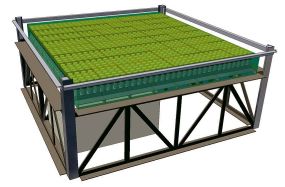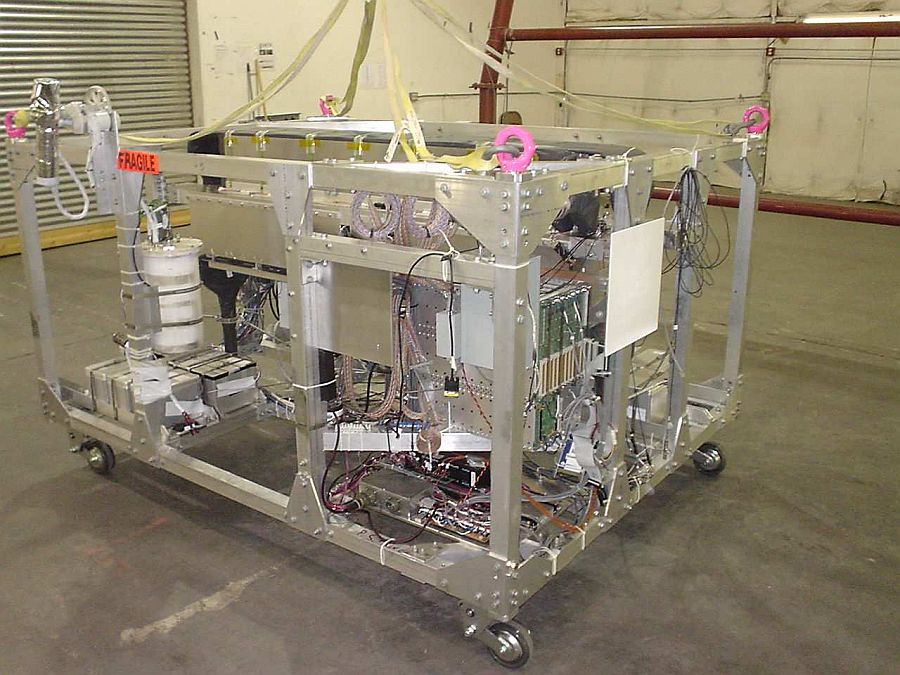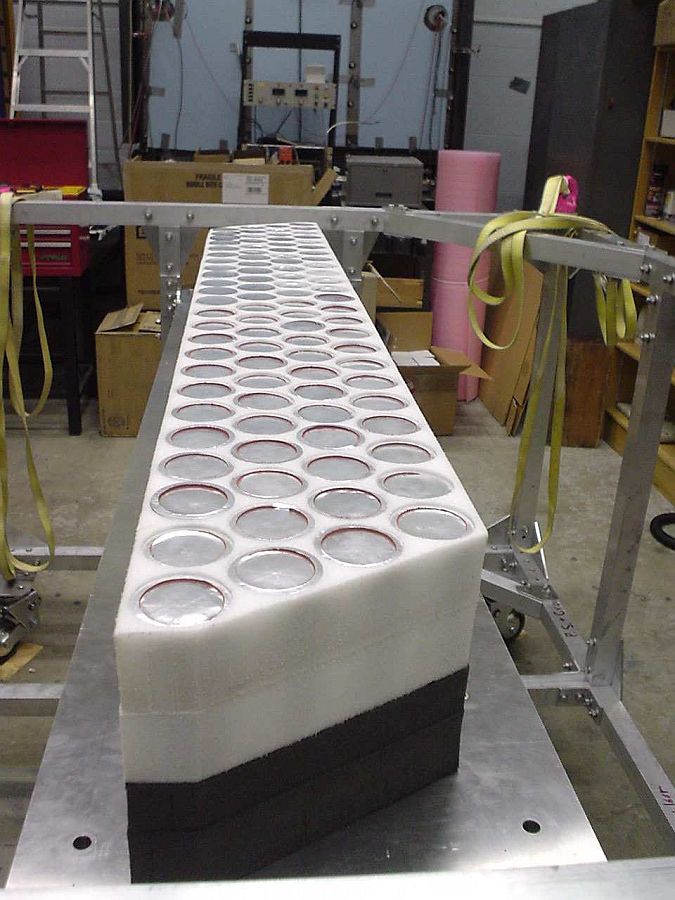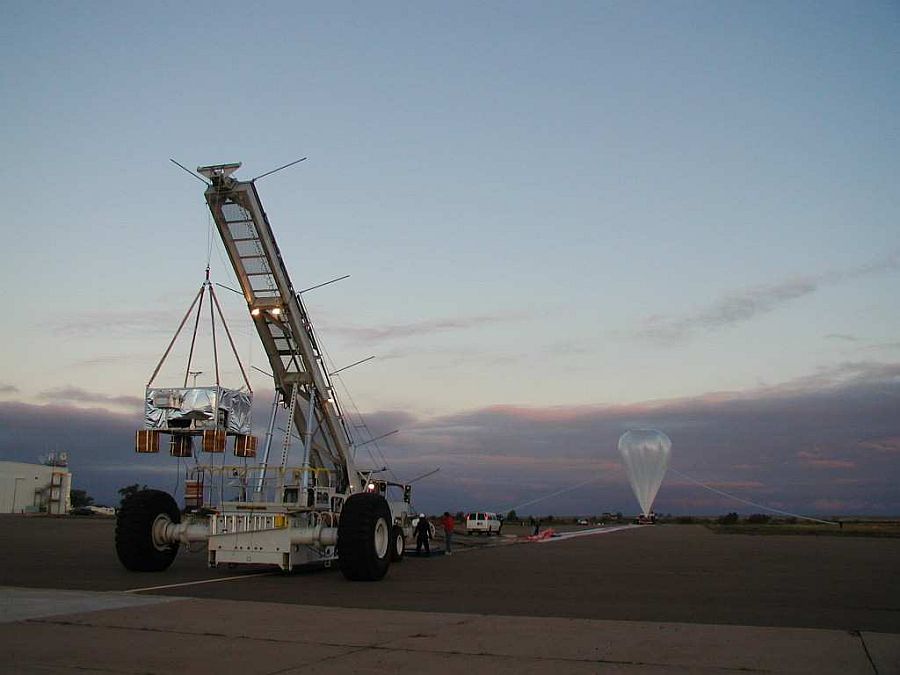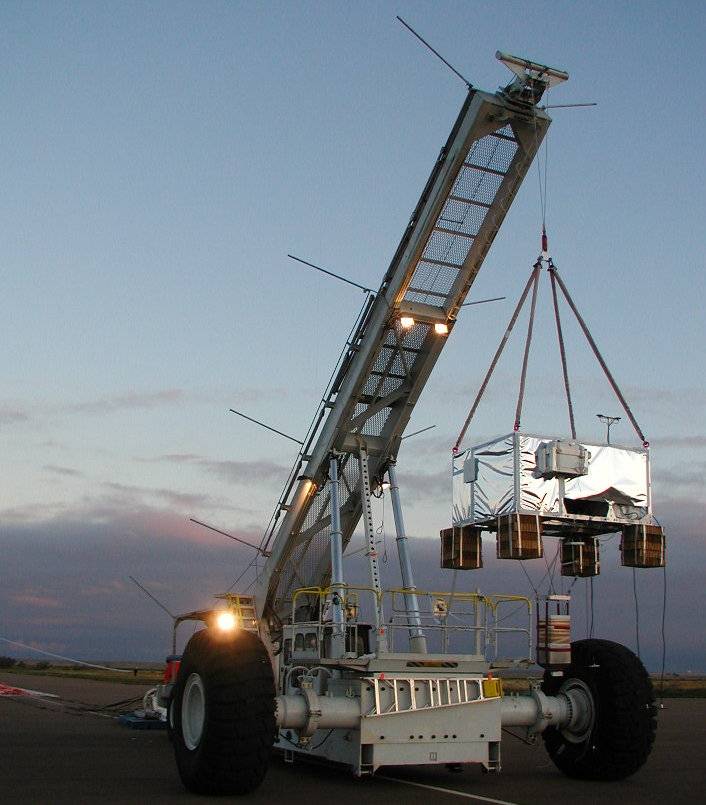Purpose of the flight and payload description
CREST was the acronym of Cosmic Ray Electron Synchrotron Telescope a balloon payload designed to measure the flux of primary cosmic ray electrons at energies greater than 1 TeV. It was developed throught a collaboration between Indiana University, University of Michigan, University of Chicago, Pennsylvania State University and Northern Kentucky University.
Working principle As electrons at these high energies lose energy very rapidly during propagation through the interstellar medium, their detection would indicate the existence of sources that are nearby on a Galactic scale. In order to obtain the large exposure time and detector aperture required for this measurement, the approach used in CREST is based on the detection of synchrotron photons emitted by electrons in the Earth's magnetic field. This technique has been suggested over the years but has never been fully exploited until now. It allows very large detector apertures, since the instrument need only intersect a portion of the line of photons, which extend over hundreds of meters of space, and not necessarily the electron itself. Conceptually, the detector has an effective area determined by the spatial extent of the synchrotron x-rays, and not the physical size of the detector.
The characteristic synchrotron photon energies range from 50 keV up to tens of MeV. These photons are emitted in a very narrow cone resulting in a line of photons many hundreds of meters long at balloon altitude, whose average energy is a strong function of the primary electron energy. To separate signal events from background photons, two characteristics of the radiation must be exploited: the formation of a line of photons at the detector, and the very short time interval over which these photons are detected.
Above left we can see a basic scheme of the instrument. The main active detector of the CREST instrument was made of Barium Fluoride (BaF2) which was choosen based on its relatively high density and light yield, particularly in its fast scintillation component, which provided single photoelectron timings of well under 1 nano second. A total of 1024 crystals, 2 cm thick with a diameter of 5cm were deployed in a square pattern, with a 7.5 cm pitch in both orthogonal directions, covering a total area of roughly 2.3 x 2.3 m2. The body of the array was divided into 8 mechanical subunits, facilitating shipping and recovery.
A custom photomultiplier tube (PM) active base unit optimized for this application was developed. The PM included a low power voltage divider. To accommodate the short wavelength response of the crystal's fast component, both faces of each crystal were coated with tetraphenyl butadiene (TPB) waveshifter. The crystal was covered with a highly reflective teflon film wrapping. A LED-fed optical fiber system provided each PMT with timing and signal amplitude calibration pulses during flight.
Each crystal was shielded from multiple Compton scattered background photons by a 4 mm thick, 60 mm long lead layer. Finally, the crystal array was segmented in blocks of 16, with each block supported in a matrix of polyethylene foam. The crystal array was surrounded on all sides by a 0.5 cm thick plastic scintillator veto shield. To maximize light output, the scintillators were wrapped in a highly reflective TEFLON-based diffuse lining material. CREST used a custom distributed electronics system to collect timing and pulse height information from the array and its anticoincidence shield, managed by a flight computer system based on a Pentium-M class single board computer with USB interfaced flash memory data storage.
The instrument's structural backbone was a gondola made of aluminum alloy corner posts, carbon fiber composite cross-members, and a bed of aluminum alloy channels which support the array (above) and front end electronics (below), as shown in the scheme above left. The instrument performance benefited strongly from high float altitudes, both in terms of reduced backgrounds and reduced signal attenuation. CREST was designed to meet the weight ceiling of 1800 kg required to achieve a float altitude of 39 km.
The CREST project had two phases: CREST-1, flown in 2005, carrying a prototype array designed to validate the technique, and CREST-2 flown in 2009 that carried the full detector in the same configuration flown in Antarctica in 2011.
The primary objective of this flight (CREST-1) was the direct measurement of the x-ray background count rate and energy spectra as a function of atmospheric depth. CREST-1 consisted of an array of 96 scintillator crystals (50 mm dia. x 10 mm) surrounded by a veto system used to reject signals due to penetrating charged particles. Each scintillator crystal was optically coupled to a photomultiplier tube and was read out by custom electronics that measured the signal amplitude from 1 keV to 10 MeV and relative timing to 250 ps. A multilevel trigger level selected events for post-flight analysis.
Details of the balloon flight
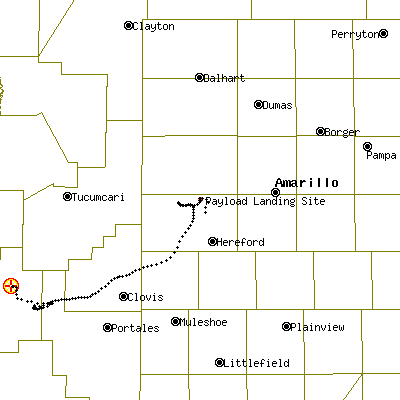
Balloon launched on: 10/7/2005 at 13:30
Launch site: Scientific Flight Balloon Facility, Fort Sumner, (NM), US
Balloon launched by: National Scientific Balloon Facility (NSBF)
Balloon manufacturer/size/composition: Zero Pressure Balloon Raven - 39.570.000 cu ft - (0.8 Mil.)
Balloon serial number: W 39.57-2-49
Flight identification number: 551N
End of flight (L for landing time, W for last contact, otherwise termination time): 10/7/2005 at 22:04 utc
Balloon flight duration (F: time at float only, otherwise total flight time in d:days / h:hours or m:minutes - ): 8 h 34 m
Landing site: 15 miles NNW from Hereford, Texas, US
Payload weight: 930 lbs
Overall weight: 2211 lbs
Balloon flight The balloon was launched using the dynamic method assisted by launch vehicle (Big Bill) at 7:30 MDT on October 8, 2005.
After an initial ascent around 10:15 am, the balloon reached float altitude of 41,972 m, setting a new record of altitude for a CSBF scientific payload. After floating for 1 hour and 15 minutes at that altitude, the balloon was valved-down, and started descending slowly and continuously. It followed a route to the east with a tiny desviation to the north entering in the state of Texas (click on the map at left to see the full flight path).
Finally, the flight was terminated at 16:05 MDT the same day. The payload impacted the ground at 16:53 MDT 15 miles North-Northwest from Hereford, Texas. Payload landed upright and in excellent condition.
Scientific mission Right after launch, while the balloon was ascending 91 out of the 96 crystal/PMT assemblies and all of the veto plastic PMT assemblies were successfully read out. After reaching shower maximum (at 80.000 ft) during ascent the housekeeping module malfunctioned. Hence, the CSBF provided altitude, pressure, and temperature profiles after the flight. Furthermore, just before the CREST-I instrument reached float altitude, one module (16 BaF2 crystal/PMT assemblies) malfunctioned.
Around 11:30 MDT, the balloon was valed down and started descending slowly and continuously. During this slow descent, the entire electronics system malfunctioned. After an attempt to recover by power cycling the instrument and then waiting a half hour, contact was regained with the CREST-I instrument. This persisted for the rest of the flight, and data taking continued for 15 minutes followed by 30 minutes of rest.
Even though the CREST-I instrument had experienced hardware difficulties as described above, the collected data served to quantify the functionality of the electronics, which will be useful for the Antarctic flight. In addition, the diffuse and atmospheric X and Gamma Ray energy spectra were succesfully measured.
External references
- CREST website University of Indiana
- CREST: A Cosmic-Ray Electron Synchrotron Telescope to measure TeV Electrons 29th International Cosmic Ray Conference 2005, Pune, India
- Progress Report 2005
- Prototype Development and Simulation of the Cosmic-Ray Electron Synchrotron Telescope (CREST) University of Michigan - Dissertations And Theses 2009
- The Cosmic Ray Electron Synchrotron Telescope (CREST) Experiment 30th International Cosmic Ray Conference, Merida, MEXICO
- The Flight Electronics System for the Cosmic Ray Electron Synchrotron Telescope (CREST) Experiment 30th International Cosmic Ray Conference, Merida, MEXICO
707If you consider this website interesting or useful, you can help me to keep it up and running with a small donation to cover the operational costs. Just the equivalent of the price of a cup of coffee helps a lot.

